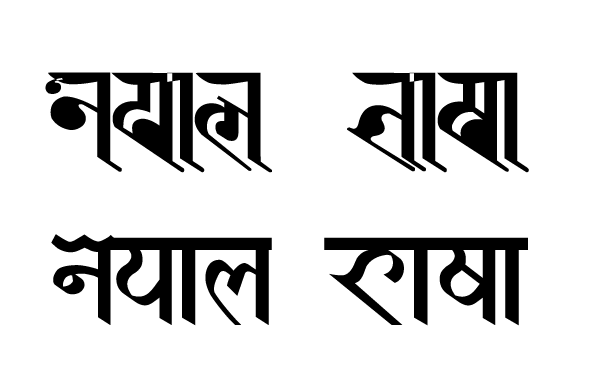Newar language: Difference between revisions - Wikipedia
 Article Images
Article Images
m
Line 27:
== History and development==
[[Image:Prachalit.JPG|thumb|right|250x|A historical inscription in Bhaktapur Durbar Square in Nade Nepali language, the state language. The continued enforcement of the language over 30 years made Khas language or Nepali the lingua franca as well. Oher languages including Nepal Bhasa]] were cast aside as the population could not use it for official, educational or for legal activities.
Little is known about the origins of Nepal Bhasa except that the language has evolved with continued influences from Tibetan, Kirati, Maithali, Pali, Sanskrit, Khas, Hindi and other languages of the region. The language largely replaced Sanskrit as the official language of medieval Nepal as the language used in the ''shilalekh'' or stone scripture.
Nepal Bhasa has undergone continuous change through time. The language can be classified into old era and new era language. Although there is no specific demarcation between the two, mid-Rana regime of Nepal i.e. around 966 to 1061 N.S. is taken as the period of demarcation between the two <ref>Pulangu Nepalbhasa Wangmaya-muna by Kashinath Tamot</ref>.
Modern Nepal Bhasa is the most Indianized of the Tibeto-Burman languages. It has had many centuries of contact with neighboring [[Indic languages]].
===Ancient era===
The earliest known (dated) document in Nepal Bhasa is called "The Palmleaf from Uku Bahal" which dates back to 1114AD (235 NS) <ref>The Earliest Dated Document in Newar: The Palfleaf from Uku Bahah by Dr. Kamalprakash Malla</ref>. A few lines from the script read<ref>Pulangu Nepalbhasa Wangmaya-muna by Kashinath Tamot</ref>:
<blockquote>
छीन ढाको तृसंघष परिभोग। छु पुलेंग कीत्य बिपार वस्त्र बिवु मिखा तिवु मदुगुन छु सात दुगुनव ल्है।
</blockquote>
which is a general discussion of business transactions. This document dates from Lichchhivi period. Hence, it can be inferred that although the official language of the period was Sanskrit, Nepal Bhasa was already in use.
===Medieval era===
The language continued growing in the Medieval period, and enjoyed royal patronage. Noted royal writers include [[Mahindra Malla,]][[Siddhinarsingh Malla]], [[Jagatprakash Malla]] etc. An example of the language used in that period is provided by lines of Mooldevshashidev written by Jagatprakash Malla<ref>Mooldevshashidev by Jagatprakash Malla, edited by Saraswati Tuladhar</ref>
<blockquote>
:धु छेगुकि पाछाव वाहान
:तिलहित बिया हिङ लाहाति थाय थायस
</blockquote>
which is a description of [[Shiva]], and the use of a tiger skin as a seat for Shiva.
The language replaced [[Sanskrit]] as the administrative language during this period.
===Dark ages===
The language faced a setback after unification of Nepal in 17th century. The language spoken by hill people became the court language.
Furthermore,the literature, scripts etc. of the language were put in shadow during the 104 years of aristocratic "Rana rule"(1846-1950 AD). During this time, legal documents made in Nepa Bhasa were declared as non-usable and any evidence in Nepal Bhasa was declared null and void. There was no state support afterwards too.
During the autocratic rule of King Mahendra called Panchayat (which followed the coup-de-etat that deposed the democratically elected bodies of Nepal), a new policy was brought called "Ek Bhasa Ek Rashtra" (One language one nation). This policy made Nepali language the only state language and the other languages were in shadow as "ethnic" or "local" languages. The implementation of this policy made Nepali language, the state language. The continued enforcement of the language over 30 years made Khas language or Nepali the lingua franca as well. Oher languages including Nepal Bhasa were cast aside as the population could not use it for official, educational or for legal activities.
===Renaissance era===
Line 70 ⟶ 37:
<blockquote>
:सज्जन मनुष्यामनुष्यSFGSा संगतनंसंगASDतनं मूर्ख नापं भिनाभिनASDGा वै
:पलेलापलASDGेलASDGा लपते ललSDGSG वंसा म्वतिमSADHG्वति थें ल सना वै
</blockquote>
Line 79 ⟶ 46:
A lot of writers and thinkers have contributed to the modern form of Nepal Bhasa. These include [[Chittadhar "Hridaya"]], [[Durga Lal Shrestha]] etc..
During the Panchayat era, under the slogan of "एक देश, एक भाषा नीति" (one nation, one language), Nepal Bhasa (and other languages of Nepal) was prevented from being broadcasted in Radio Nepal or other government media. As the Government did not allow private broadcasting in Nepal, this prevented the language from mass media. Also, the term Newari was used to address the language instead of "Nepal Bhasa" which met fierce criticism and resistance. This marked the beginning of [[Nepal Bhasa movement]]. Instead of using mass media, people started producing audio cassettes. Also, the first Nepal Bhasa movie "Silu" marked the beginning of movies in Nepal Bhasa. Nepal Bhasa movement aimed to end the one nation, one language policy. Some linesines from the famous poet [[Durga Lal Shrestha]] of this era are as follows<ref>नेपालभाषाया न्हूगु पुलांगु म्ये मुना ब्वः१ </ref>-
<blockquote>